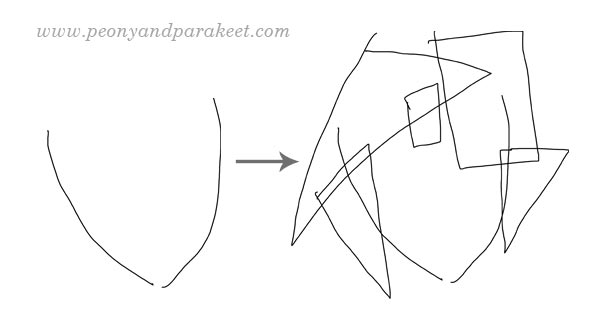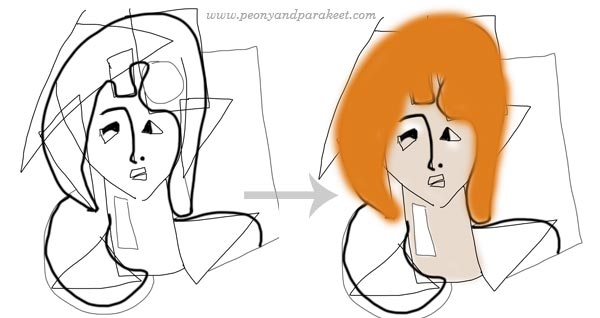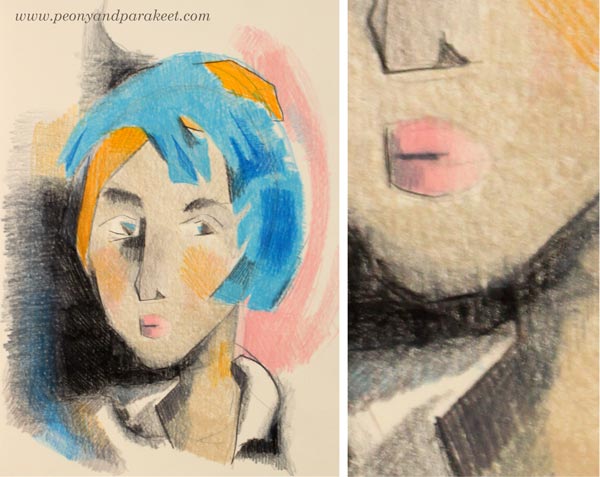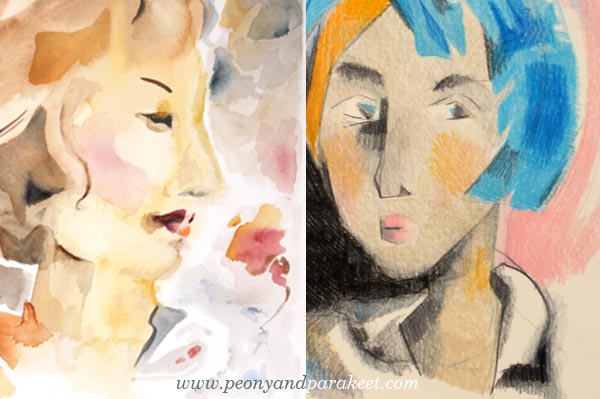Helene Schjerfbeck – Step-by-Step Formula for Her Style

In this blog post, I will show you how to create a stylish portrait and learn from a Finnish artist Helene Schjerfbeck (1862-1946).
The Famous Helene Schjerfbeck
Helene Scherfbeck had an impressionistic and fairly detailed style. But during the years, she became a true expressionist, a master of expressing the most essential through simplifying. She painted a lot of portraits, and many of them have become very valuable. The Red Haired Girl II was sold for 1.5 million euros at Sotheby’s last year. One of my aunts admired Helene Schjerfbeck, and many years ago, she bought me a book about her paintings. The book is called “Helene Scherfbeck – Elämä ja taide” (Life and Art), and it’s written by Lena Holger. To be honest, I wasn’t a big fan of the style and didn’t even browse the book for years. But the more I have learned about art, the more enthusiastic I have become to study various styles. As I love to figure out a formula behind a style, it started to feel tempting to solve Helene’s secrets too.

Independent Visions – Helene Schjerfbeck in New York!
There’s also another reason why I am writing this. Currently, there’s a rare opportunity to see Finnish female masters in New York, USA. The Ateneum Art Museum, which is part of the Finnish National Gallery, displays an excellent exhibition at Scandinavia House from 29 April to 3 October 2017. The exhibition presents four early 20th-century Finnish artists from the Ateneum collection: Helene Schjerfbeck, Sigrid Schauman, Ellen Thesleff and Elga Sesemann. If you visit New York this summer, do go and see it, I promise you won’t be disappointed!
Here are a couple of Helene Scherfbeck’s paintings that you will see there.

I find the abstract nature of Helene’s style especially fascinating. The way she simplifies the spots where the light hits or where a shadow is formed is like she is building an abstract composition instead of painting a face.
Furthermore, the girl below is wearing a shawl that is like an abstract painting!

Mixing Helene Scherfbeck’s Style with My Personal Approach
One primary factor in building a style is the shape of the elements. I for one love organic elements and flowing form. Simple rectangles are not as appealing to me as more complicated and diverse shapes. However, I wanted to add Helene’s twist to a couple of watercolor paintings. As Helene Scherfbeck also painted still-lifes, I decided to paint a woman with a flower or two. First, I made a tiny painting and played with layers to create angular shapes. Then I painted a bigger watercolor painting with familiar flowing shapes but using the insights that I had got by painting the first one.

After these two paintings, I was ready to record a simple formula for achieving Helene Scherfbeck’s style.
The Formula for The Modern Woman – Step by Step!
During this drawing process, improvise, but also check that your drawing is not symmetric. It makes the drawing dynamic and reduces stiffness.
1) Draw a couple of arcs to create a face. Then add rectangles and triangles for hair. It is a fun and easy way to add hair without focusing on the shape of the head.

2) Add a neck and shoulders by drawing a rectangle and a couple of triangles that point to different directions. Then draw eyes, mouth, and other facial features. Use as many geometric shapes and simple lines as you can. After facial features, turn the work upside down and complement the drawing with geometric shapes so that it’s more like a balanced, asymmetric abstract painting than a portrait of a woman.

3) Soften the shape of the hair, the clothing, and some of the facial features. Then color the face, neck, and hair. Helene Scherfbeck often used grayish colors for the skin and a more striking color for the hair.

4) Add light and shadows on the face. Use mostly simple geometric elements. Then turn the work upside down and finish the abstract composition by using color to balance the painting. Remember to maintain the asymmetry!

5) Remove some sketch lines and add more finishing details if needed. If you used long lines, make some of them shorter so that your drawing is not so stiff.

Helene Scherfbeck’s Style – The Combination of Simplicity and Softness
Even if Helene Scherfbeck’s style is very graphic, she also embraced uneven edges and soft color changes. This softness combined with distinct, even clumsy-looking geometric elements is the essence of her style.

She also uses strong lines and bold colors to draw the viewer’s attention to the selected details. However, she does that very sparingly like there would be a limited storage of lines and pigments.

Find The Passion Behind Your Many Styles
I often find it distracting when people talk about their personal style like it would be the final destination for their artistic journey. They say tat once they have found their style, it would be like coming home and they would never need to go back to explore. I think it can be a harmful mindset. It leads to thinking that artists could be divided into three categories: a) those who search their style, b) those who stick with their style, and c) those who are afraid of going deeper because they don’t want to stop playing. That kind of controversy is not good at all! Going deeper allows, not prohibits, playing! Creative people are meant to travel spiritually!

Instead of searching for your perfect style, your final destination, connect with your passion! Your passion can be like a base camp for your explorations, energizing you to take up new challenges.

Sign up for The Exploring Artist to discover the passion behind your art
and to become more confident with the big word “artist”!
18 thoughts on “Helene Schjerfbeck – Step-by-Step Formula for Her Style”
Comments are closed.

Pavi, I had no idea Finland is so young! Thank you for the Modern Woman lesson, I think it looks like fun. Enjoy the 100th anniversary of your country.
Thank you, Barbara!
Pavi, another inspiring lesson and expression from you. You are so generous to help me explore differences that no only apply to art but to Life.
Thank you, Paljon Kiitoksia (in honor of Finland)
Thanks so much, Linda!!
Happy 100th anniversary for Finland! I also didn’t realize Finland was that young. How exciting. Such a happy way to celebrate and I can’t wait to do this lesson. I so much admire those that can swipe a stripe of paint and light up a face. What magic and it will be fun to learn more about this. Thanks again, Paivi.
Thank you, Mary, have fun!
I like this! I too did not know Finland was so young. Happy Anniversary for Finland.
Thank you, Nancy!
Happy 100th to Finland! Thank you for the portrait formula. I find this so intriguing and will certainly give it a try. Love your words – ” Your passion can be like a base camp for your explorations.” I am copying them and hanging them on my art room “remember board.”
Cheers!
Thanks, Cathy! Have fun drawing! Great to hear that you liked what I wrote about exploration!
I also loved the line…your passion can be a base camp for further explorations! Thanks for introducing us to this interesting Finnish artist! A wonderful blog post!
Thank you, June!!
wonderful post! Thank you for helping learn to look at what I am seeing in new ways…. you are a gift.
Thank you, Isabel!
Thank you for shedding a light on the history of your country as well as several other artists to explore. This approach to portraiture looks fun and interesting- hope to try it soon!
Thanks, Stephanie, have fun drawing!
I really loved making the portrait in a style so different from mine. I have struggled (in my mind) recently with the fact that my “style” has changed dramatically. Lots of questions. Unfortunately, I am in the midst of selling my apartment and moving to Spain for a year or so, and all the work involved in accomplishing that. I hope youll offer the class again.
Thanks, Imelda! I haven’t scheduled next year yet, but most probably I will have a coaching program then too.